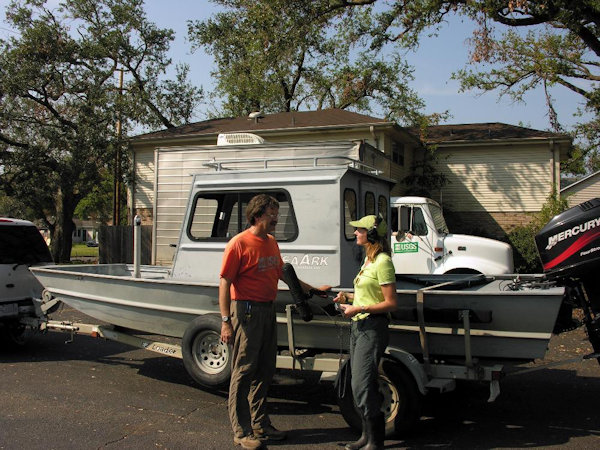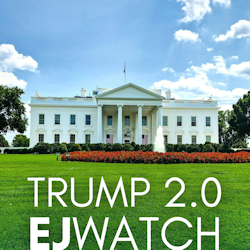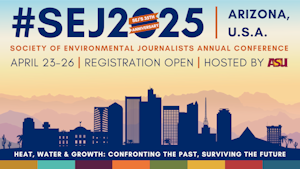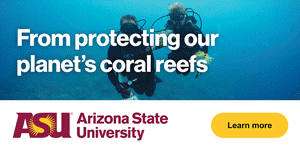SEJournal Online is the digital news magazine of the Society of Environmental Journalists. Learn more about SEJournal Online, including submission, subscription and advertising information.
 |
 |
| A public radio reporter interviewing a government scientist in September 2005 about bacteria in Lake Pontchartain, Louisiana, following Hurricanes Katrina and Rita. Photo: U.S. Geological Survey (United States government work). |
Feature: With Scientific Research Under Attack, Journalists Must Up Their Game
By Matt DeRienzo
Newsrooms face a profound challenge this year: how to confront — and just keep up with — a barrage of massive changes to U.S. government policy, underpinned by rhetoric that challenges long-established scientific consensus.
This is not some drill for a reporter assigned to a wonky science beat that few news organizations even have anymore. It cuts across issues that will have, and already are having, real-world, life-and-death impacts on the communities all journalists cover.
People are dying from measles (may require subscription) — an infectious disease that the United States eliminated 25 years ago — while the leader of the federal government’s top health agency questions vaccines and recommends cod liver oil and vitamins as a treatment.
Terms related to climate change (as well as many other words) are being banned and related research canceled.
The U.S. Environmental Protection Agency is moving to reconsider its landmark 2009 finding that greenhouse gases are a threat to public health and to eliminate a host of related industrial regulations.
And those are just a few examples from a list that grows longer and more far-reaching by the day.
At no other point in our lifetimes has it
been more important for the public
to understand scientific research.
At no other point in our lifetimes has it been more important for the public to understand the scientific research that has helped protect us from disease and pollution, and begun to steer us toward mitigation of climate-driven disaster.
SciLine, a nonprofit organization that was founded in 2017 to help journalists access, understand and incorporate scientific research and expertise into their reporting, was built for this moment.
Sources, trainings, tools and tips
 |
The SciLine team — which includes a mix of scientists and journalists — helps newsrooms and freelancers through a wide range of services.
We provide a unique and popular service that matches reporters with expert sources on deadline. We hold briefings with scientists to provide context and background on timely topics for journalists. We have a special program that helps local TV stations go beyond sound bites with expert sources who are good on camera. We train journalists in the essentials of scientific research and how to avoid common mistakes that can lead to inaccuracy and mistrust.
And now, to help journalists meet the extraordinary challenges of 2025, we have published a tool kit with resources for navigating coverage of our chaotic news cycle and the attacks on scientific consensus that are accompanying it.
Evidence-Based Reporting Tools and Tips for 2025 is a guide for journalists on how to understand, access and incorporate scientific research into their work.
Topics it covers include peer review, scientific consensus and how to write about scientific uncertainty and avoid jumping to conclusions not supported by the research.
The tool kit also includes deep background context and a guide to common misconceptions about some of the major issues being thrust into the spotlight this year.
It answers questions such as: How does climate change relate to drought, flooding, heat, cold? How do scientists determine whether a severe weather event is climate change-driven? How are vaccines developed? How effective are they? How do scientists determine their safety?
Our new tool kit also includes a guide to free, ongoing services offered by SciLine and other organizations, including The Journalist’s Resource, a program based at Harvard University’s Shorenstein Center whose work is included in the tool kit, The Open Notebook and journalism membership organizations such as the Society of Environmental Journalists and the Association of Health Care Journalists.
Understanding and explaining evidence-based research
Research shows that people who understand not just the conclusions of scientific research, but how scientific research actually works, are less likely to fall for misinformation or believe in pseudoscience.
For example, there’s a through line from that time in the early days of COVID — when we were washing our mail and groceries, and then two weeks later told to stop doing that and wear masks instead — to vaccine hesitancy pushing us into measles outbreaks.
People’s faith in both scientists and journalists is eroded by reporting that brushes aside the significant uncertainty in scientists’ recommendations and treats them as absolute conclusions handed down from on high, only to be replaced with a different edict a short time later.
Evidence-based scientific research exists
on some aspect of almost every topic
that environmental journalists cover.
Evidence-based scientific research exists on some aspect of almost every topic that environmental journalists cover.
Understanding it leads to more accurate reporting and helps equip people with information they need to make better decisions about their family’s health and well-being, and to influence public policy.
More accurate reporting can also be a powerful trust-building tool for newsrooms trying to serve an audience that is more polarized than ever — because it steps back from the political back-and-forth to provide independent context, supported by evidence.
If nothing else, the fact that politicians are moving to cancel and censor scientific research right now should be a wake-up call to newsrooms about the relevance of evidence-based scientific research to their work and the importance of understanding and explaining its methods and value to the public.
[Editor's Note: Also see our related feature, “Expert Advice Helps Journalists Navigate Unfamiliar Scientific Seas,” drawn from a SciLine course on science essentials for local reporters.]
Matt DeRienzo is director of SciLine, a nonprofit organization housed at the American Association for the Advancement of Science that helps journalists access, understand and incorporate evidence-based scientific research and expertise into their work. He has more than 30 years’ experience as a reporter, editor, publisher and journalism nonprofit leader, including serving as editor-in-chief of the Center for Public Integrity, vice president of news for Hearst’s Connecticut newspapers and LION Publishers’ first full-time executive director.
* From the weekly news magazine SEJournal Online, Vol. 10, No. 14. Content from each new issue of SEJournal Online is available to the public via the SEJournal Online main page. Subscribe to the e-newsletter here. And see past issues of the SEJournal archived here.













 Advertisement
Advertisement 



